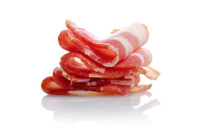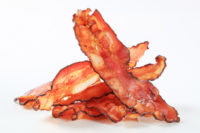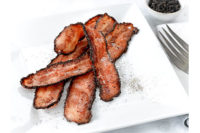Bacon Report: The Bacon Revolution Continues

Bacon’s love story with the American public isn’t over just yet.
Despite meddling influences such as rising prices and a rough economy, consumers are still willing to pay higher prices for its flavor, aroma and adaptability. And its cult following remains essentially unchallenged.
Last year, total bacon sales were up 2.7 percent in dollar sales and 3.3 percent in unit sales, according to The Nielsen Co., based in New York, during the 52 weeks ending July 10, 2010 (U.S. food, drug and mass merchandisers, including WalMart).
“Generally, processed-meat sales stay pretty constant, so a three percent sales increase is really good,” says Kristin Clemmer, director of marketplace strategy and communications, Fresh Mark Inc., based in Canton, Ohio. “Some standouts we saw were slab bacon and specialty items [such as] applewood-smoked flavors.”
In 2009, in fact, the pork industry produced 3.7 billion pounds of bacon (which is calculated by averaging the weight of the bellies times the number of hogs harvested), says Jarrod Sutton, assistant vice president, channel marketing, National Pork Board, based in Des Moines, Iowa.
“Bacon demand is currently at an all-time high thanks to many of its positive attributes, most notably flavor,” he says. “Bacon makes everything better, like a chicken sandwich, or a cheeseburger, or an omelet.”
The popularity of bacon is leading to its current all-time high prices, which should last through 2011, because increased demand is leading to a tighter supply. In 2009, bacon was very plentiful and inexpensive, so processors cut back on their supply of fresh pork bellies. As of August, fresh pork bellies were priced at $1.35 a pound, which is 53 percent higher than last year, according to the Wall Street Journal.
The price of bacon at retail has been steadily climbing this year as a consequence, with the full impact expected to hit consumers in late 2010 and 2011.
“Consumers have stayed the course and accepted the inflation, further proving that our meticulous, frugal-shopping consumer will not sacrifice flavor,” says Sutton.
Shoppers are showing more interest in different packaging options though, such as family size and smaller 12-ounce sizes instead of the typical one-pounder, Clemmer says, so it’s possible that rising prices will just shift consumer attention to more affordable alternatives.
Doubling down on flavor
The bacon industry certainly couldn’t ask for better customers. In the last few years, the product has developed an almost cult-like following. The Internet has thousands of blogs devoted to it; communities host bacon camps that attract hundreds of people; bacon-related merchandise is wildly popular; bacon eating and cooking contests regularly take place; bars sell bacon-based cocktails; and restaurants host “Bacon Nights.” Bacon also dominates food discussions in the social-media world.
“Name another meat that has multiple blogs devoted to it and clothing and accessories that are produced to look like the real thing,” says JP Bittencourt, bacon brand manager, Oscar Mayer Foods Corp., Madison, Wis.
Young and old alike seek it out for its taste and aroma, but the biggest group of consumers fall in the 35- to 49-year-old range, reports the National Pork Board.
Clemmer adds that there’s also a migration to comfort foods in times of economic stress. Indeed, consumers are staying in and preparing more meals at home, and as a result restaurant sales are slightly down. This behavioral shift is affecting the product mix at retail and foodservice, says Gary Karp, executive vice president, Technomic, a Chicago-based research and consulting firm.
“But because of bacon’s many applications, it has remained somewhat steady in foodservice,” he says. Generally, the bacon choices at grocery have been more traditional and straightforward, but more stores are carrying interesting smoked flavors such as applewood and premium center and thick cuts. Still, Clemmer says, there are limitations.
“Big, bold flavors are more for the foodservice industry,” she explains. “We see more innovation coming from that side. No one wants to fry jalapeno bacon, for example, at home.”
Since the demand for raw bacon has started to slow since Easter at retail, due to the higher raw bacon prices, the situation has benefited the pre-cooked and turkey bacon segments, as both have experienced even stronger growth in past months, says Bittencourt.
“Turkey bacon is becoming more popular with consumers,” he says, noting that turkey bacon has 50 percent less fat than pork bacon. “It’s a great alternative for anyone who’s making lifestyle changes but isn’t quite ready to give up their favorite foods.”
Pre-cooked bacon may be popular but won’t sell more than raw bacon, because it’s hard for consumers to look at it as the same value and amount as raw bacon and doesn’t pack the same aromatic punch, notes Karp.
“It’s definitely more convenient though and great for brown bagging,” he says.
Smoking the competition
Breakfast has been one of the bright spots in foodservice during the recession, and bacon definitely is key to the breakfast daypart. Many fast-food and restaurant operators, such as Wendy’s, Burger King, Subway, Corner Bakery and KFC, are paying renewed attention to its possibilities.
In 2010, Wendy’s changed to a thicker-sliced, applewood-smoked bacon, which the fast-food operator is selling as a premium add-on to any sandwich, including “The Baconator.”
This change has given additional momentum to the bacon category, notes Sutton.
“First, the multi-million dollar national ad campaign promoting its bacon served Wendy’s well, but it also reached further by elevating the awareness for bacon with consumers,” he says. “The increased awareness coupled with the success Wendy’s was [and still is] experiencing in terms of sales prompted other quick-serve restaurants to take notice. Competitors either have or are currently evaluating their bacon specs with the hopes of improving the quality and charging a bit more for it.”
Within foodservice in general, any unique flavor is of interest to consumers. “Applewood and jalapeno bacon give distinction to menu choices,” says Clemmer. “Going forward, when prices rise, we might see more careful use of bacon by chefs, who want to highlight the bacon’s flavor but won’t need as much to give dishes a special note.”
According to Karp, consumers may not necessarily be asking for new bacon flavors but are open to them.
Bacon has proven to be very adaptive to all kinds of applications, so consumers can only expect to see more unique uses, says Karp. He points to Corner Bakery’s BBLT (double bacon lettuce tomato) sandwich and KFC’s Double Down sandwich, which uses two chicken filets wrapped around cheese, bacon and the Colonel’s sauce, as examples.
“Product innovators are using bacon in many ways because of its popularity and the additional flavor it provides to products,” says Karp. “Chicken and turkey have neutral flavors, and bacon adds flavor to them.”
Karp says to expect more breakfast rollouts in the first quarter next year, so bacon will continue to register incremental sales.
“We will continue to see a very healthy environment for bacon,” he says. “Prices may slow down a little. But I think these prices are a blip on the way to continued interest in the bacon category.”
Looking for a reprint of this article?
From high-res PDFs to custom plaques, order your copy today!






